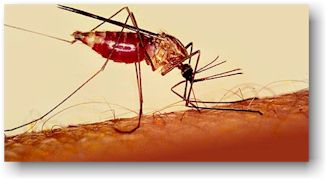
Insects put disease on the battlefield
Malaria kills 60,000 Northerners
By Tom Howell, Jr. (Washington Times, 3/18/06)
Twice
as many Civil War soldiers died from insect-related
disease as from combat, an
obscure I fact that Laurel resident Gary Miller has
discovered in his unique
decades-long hobby.
Since the 1970s, Mr. Miller, 48, has pored over books, soldiers' letters and regimental histories for insect references. He has found that mosquitoes, body lice
and flies were constant nuisances to Union and Confederate soldiers. Roughly
160,000 soldiers died from malaria on the Union side alone, he says.
“I think the beauty of looking at the insects is it's a topic that we
all can relate to,” he says. “Few of us can relate to combat!”
Mr. Miller is a professional entomologist who describes new species for
the US. Department of Agriculture. His blending of bug expertise with the War
Between the States is strictly a hobby, he says.
The bugs-and-war fascination started in college, he says, when research for a Civil War course paper on
soldier life led to an unexpected trend.
“Here were all these references to insects,”
Mr. Miller says. “You find out insects played a role in every part of soldiering!”
Civil War soldiers were encamped in conditions that were awful for humans, but
great for insects.
“One of the things that most people aren't
aware of when they think of the Civil War is the number of people and associated
animals. [Armies] weren't , mechanized. They had to rely on horses and mules.”
Soldiers sometimes would travel with 8,000 to 10,000 head of cattle,
providing plenty of food for flies, he says. Soldiers, already wracked by
diarrhea or dysentery, often had to deal with mosquito-borne malaria as well. As if that weren't bad enough, he adds,
soldiers' food usually was infested.
Mr. Miller owns an original letter by a soldier who wrote after the fall of Vicksburg that “every biteful of food” contained
insects. Desperation led to quirky delousing methods. Soldiers practiced “skirmishing,”
squishing bugs and lice with the thumb and forefinger on their bodies. Often
they boiled their clothes.
Historians say the Civil War was the last major war fought before
scientists realized microbes carry disease, so treatment was limited,
according to Mr. Miller.
Quinine imported from South America was the best treatment for malaria,
but the Union blockade on shipping led to price gouging. In 1862, an ounce of
quinine cost about $5, but by the end of the war, the going price in some
places was $500 to $600 per ounce, Mr. Miller says.
The average Union private made $16 per month.
In his presentations to audiences, Mr. Miller shows Civil War-era
photographs that depict these harsh conditions. Viewers must look closely to
notice the details, but the suffering of battle will be evident.
“I try not to sugarcoat things,” Mr. Miller says. “I'm not overly
graphic with the info, but the topic is war, and it’s not fun and games.”
Geri Drymalski, a naturalist with the Maryland National Capital Park
and Planning Commission, saw Mr. Miller present his research to the Maryland
Entomological Society 10 years ago.
“Well, I think it's really amazing,” she says. “We are so ignorant of
how directly and indirectly insects are part of our lives. There's so much
more to this whole drama of fighting a war than guns and bullets.”
“It's a connection to the past, and that's what you build upon,” Mr.
Miller says. “When I can bring natural history into our national history, the picture
becomes more colorful.”
